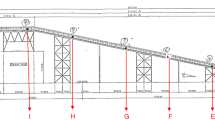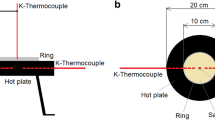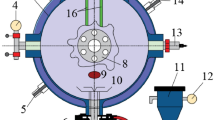Abstract
The explosion characteristics, such as maximum explosion pressure, rate of explosion pressure rise, explosion efficiency, were investigated to determine the roll and significance of oxygen consumption energy in dust explosion. Dust explosion experiments were conducted in a Siwek 20L spherical explosion apparatus for three wood dust samples from a wood-based panel production factory. Unlike gas explosions having maximum explosion pressure at near chemical stoichiometric concentration, both the maximum explosion pressure and the maximum rate of explosion pressure of wood dusts appeared at three times or much higher equivalence ratio. Although there were differences in particle size among tested dusts, in the case of dust of which the mean particle size was not larger than 100 µm, Pmax appeared at lower equivalent ratios when mean particle sizes were smaller and at higher equivalent ratios when mean particle sizes were relatively larger. Explosion efficiency for all dusts are around 10 %, of which the value is relatively lower than most of other normal combustion, which signifies dust explosion remains 90 % of unburned dust with high fire risks after explosion. In a dust explosion, it is difficult to estimate the weight of suspended dust participating in explosions, especially in fuel rich conditions, so a method for estimating explosion overpressure by applying oxygen consumption energy based on unit volume (1 m3, SAPT condition) was newly proposed and verified from the result of explosion efficiency. To practically apply these results to dust treating industry, the assessment procedure for dust explosion influence has been provided by introducing TNT equivalent model and its scaled distance.
Similar content being viewed by others
Change history
17 January 2017
An Erratum to this paper has been published: https://doi.org/10.1007/s12206-016-1250-y
References
R. K. Eckhoff, Dust explosions in the process industries, Third Ed., Gulf Professional Publishing/Elsevier, Boston, USA (2003).
R. K. Eckhoff, Partial inerting — an additional degree of freedom in dust explosion protection, J. of Loss Prevention in the Process Industries, 17 (2004) 187–193.
W. Wiemann, Einfluss der Temperatur auf Explosionskenngrossen und Sauerstoffgrenz-konzentrationen, VDIBerichte, Springer VDI-Verlag GmbH, Dusseldorf, Germany, 494 (1984) 89–97.
W. Wiemann, Influence of temperature and pressure on the explosion characteristics of dust/air and dust/air/inert gas mixtures, K. L. Cashdollar and M. Hertzberg (Eds.), Industrial dust explosions. ASTM Special Technical Publication, Philadelphia, USA, 958 (1987) 33–44.
W. Wiemann, Untersuchung des Explosion -sverhaltens von Methan und Kohlenstaub bei hohen Temperaturen unter vermindertem Sauerstoffgehalt, Final report project No. 321000, Westfahlische Berggewerkschaftskasse, Bergbau-Versuchsstrecke, Institut fur Explosion-sschutz und Sprengtechnik, Beylingstrasse 65, 4600 Dortmund Derne, Germany (1987).
C. D. Walther and H. Schacke, Evaluation of dust explosion characteristics at reduced and elevated initial pressures, poster summary, Bayer AG, Leverkusen, F. R. Germany (1986).
M. Bidabadi and A. Rahbari, Novel analytical model for predicting the combustion characteristics of premixed flame propagation in lycopodium dust particles, J. of Mechanical Science and Technology, 23 (2009) 2417–2423.
J. H. Lim, S. H. Lee and W. S. Yoon, A comparative study of the ignition and burning characteristics of afterburning aluminum and magnesium particles, J. of Mechanical Science and Technology, 28 (10) (2014) 4291–4300.
M. Mital, Limiting oxygen concentration for coal dusts for explosion hazard analysis and safety, J. of Loss Prevention in the Process Industries, 26 (2013) 1106–1112.
K. L. Cashdollar, Overview of dust explosibility characteristics, J. of Loss Prevention in the Process Industries, 13 (2000) 183–199.
J. G. Torrenta, E. C. Lazaro, C. Wilen and A. Rautalin, Biomass dust explosibility at elevated initial Pressures, Fuel, 77 (9/10) (1998) 1093–1097.
S. Calle, L. Klaba, D. Thomas, L. Perrin and O. Dufaud, Influence of the size distribution and concentration on wood dust explosion, Powder Technology, 157 (2005) 144–148.
C. H. Medina, H. Sattar, H. N. Phylaktou, G. E. Andrews and B. M. Gibbs, Explosion reactivity characterization of pulverized torrefied spruce wood, J. of Loss Prevention in the Process Industries, 36 (2015) 287–295.
D. J. F. Slatter, H. Sattar, C. H. Medina, G. E. Andrews, H. N. Phylaktou and B. M. Gibbs, Biomass explosion testing: Accounting for the post-test residue and implications on the results, J. of Loss Prevention in the Process Industries, 36 (2015) 318–325.
W. E. Baker, Explosion in Air, University of Texas Press, Austin, USA (1973).
W. E. Baker, Explosion in Air, University of Texas Press, Austin, USA (1973); The Effects of Nuclear Weapons, US Atomic Energy Commission, Washington DC, USA (1962).
EN14034-1: 2004, Determination of explosion characteristics of dust clouds. Part1: Determination of the maximum explosion pressure Pmax of dust clouds, European Committee for Standardization, British Standards (2004).
EN14034-2: 2004, Determination of explosion characteristics of dust clouds. Part2: Determination of the maximum rate of explosion pressure rise (dP/dt)max of dust clouds, European Committee for Standardization, British Standards (2004).
EN14034-3: 2004, Determination of explosion characteristics of dust clouds. Part3: Determination of the lower explosion limit LEL of dust clouds, European Committee for Standardization, British Standards (2004).
ISO 1928: 2009, Solid mineral fuels —Determination of gross calorific value by the bomb calorimetric method and calculation of net calorific value, ISO (2009).
EN 13821: 2002, Potentially explosive atmospheres. Explosion prevention and protection. Determination of minimum ignition energy of dust/air mixtures, European Committee for Standardization, British Standards (2002).
ASTM C96:36, Test Method for Specific Gravity and Absorption of Fine Aggregate (Withdrawn 1936), ASTM (1936).
ISO 3923-1:2008, Metallic powders —Determination of apparent density —Part 1: Funnel method, ISO (2008).
ISO 3130: 1975, Wood -Determination of moisture content for physical and mechanical tests, ISO (1975).
P. R. Amyotte, C. T. Cloney, F. I. Khan and R. C. Ripley, Dust explosion risk moderation for flocculent dusts, J. of Loss Prevention in the Process Industries, 25 (2012) 862–869.
R. Siwek and C. Cesana, Ignition behavior of dusts: Meaning and interpretation, J. of Process Safety Progress, 4 (1995) 107–119.
D. A. Crowl and J. F. Louvar, Chemical Process Safety Fundamentals with Applications, 3rd Ed., Pearson, Boston, USA (2011).
V. J. Clancey, Diagnostic features of explosion damage, Sixth International Meeting of Forensic Science (1972).
C. N. Kingery and B. F. Pannill, Peak overpressure vs scaled distance for TNT surface bursts (hemispherical charges), Memorandum report No.1518, Army Ballistic Research LAB, Aberdeen, UK (1964).
F. Lees, Lees’ Loss Prevention in the Process Industries, 4th Ed., Elsevier, Amsterdam, Netherlands (2012).
Author information
Authors and Affiliations
Corresponding author
Additional information
These authors contributed equally to this work.
Recommended by Associate Editor Jeong Park
Yun Seok Kim received his B.S. in Safety Engineering of Incheon National University in 1994. He is currently a Ph. D. candidate in Safety Engineering, Incheon National University, Korea. His research interests are in the area of explosion diagnostics and process safety, fire and disaster safety technology.
Min Chul Lee is a Professor of Incheon National University. He has worked on a number of joint government and industry projects to develop the nextgeneration, low emission, fuel flexible gas turbine combustor and fire safety technology.
Dong Ho Rie is a Professor of Incheon National University. He has worked on a number of joint government and industry projects to develop the nextgeneration, fire in Industry, fire and disaster safety technology.
Rights and permissions
About this article
Cite this article
Kim, Y.S., Lee, M.C. & Rie, D.H. Explosion characteristics of combustible wood dust in confined system: Analysis using oxygen consumption energy. J Mech Sci Technol 30, 5771–5779 (2016). https://doi.org/10.1007/s12206-016-1147-9
Received:
Revised:
Accepted:
Published:
Issue Date:
DOI: https://doi.org/10.1007/s12206-016-1147-9




